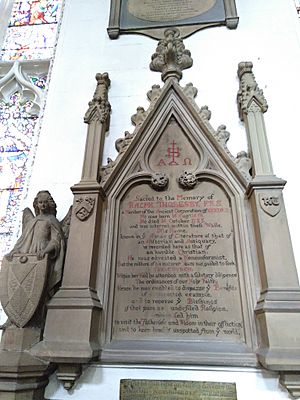Ralph Thoresby facts for kids
Ralph Thoresby (born August 16, 1658 – died October 16, 1725) was a famous historian and collector from Leeds, England. Many people say he was the very first historian of Leeds! Besides being a merchant (someone who buys and sells goods), he was also a nonconformist (meaning he had different religious beliefs from the main church), a member of the important Royal Society, a writer who kept a diary, a local council member in Leeds, and he even had his own museum.
Contents
Growing Up in Leeds
Ralph Thoresby was the son of John Thoresby, who was also a merchant in Leeds. His father was very interested in old things, just like Ralph would become. John Thoresby even had his own collection of old coins and medals, which he spent a lot of money on.
Ralph and his father were very similar. They were both deeply religious and loved studying history and old objects. Ralph went to Leeds Grammar School. When his older brother passed away, Ralph became the oldest son in the family. At 18, he went to London to learn more about being a merchant. He started writing in a diary around this time and kept it up for most of his life. Parts of his diary were published later in 1830.
From 1678 to 1679, Ralph lived in Holland to finish his training as a merchant. After that, he returned to Leeds in 1679 and lived there for the rest of his life. When his father died in 1679, Ralph took over the family business and his father's museum. He also took care of his younger brother and sister.
In 1683, Ralph faced some challenges because of his nonconformist religious beliefs. However, this didn't stop him. In 1684, he joined important trading groups called the Eastland and Hamburgh Companies, which helped him trade goods with other countries.
On February 25, 1685, he married Anna Sykes. Her father, Richard Sykes, was one of the important landowners in Leeds. In 1689, Ralph started a mill to make oil from rapeseed, but his business ventures weren't very successful.
Becoming a Historian and Collector
In 1690, Ralph Thoresby met William Nicolson, who was a well-known historian and later became a bishop. After this meeting, Ralph decided to write a history of Leeds and the areas around it. Over the next ten years, his reputation as a historian grew. People became very interested in his museum, and visitors to Leeds often wanted to see it.
Because of his studies of old Roman objects, Ralph was chosen to be a member of the Royal Society in 1697. This was a big honor! He also became a council member in Leeds that same year. In 1699, he decided to no longer be connected with the nonconformist groups.
Around 1704, Ralph stopped working in business. He had a small income and spent his time on his museum, his writing, and his religious practices. In 1715, he published his book, Topographical Survey of the Parish of Leeds. This book described the area and also included a list of all the interesting things in his museum.
It's said that his museum even had Sir Walter Raleigh's tobacco box from at least 1719! It was described as being seven inches wide and thirteen inches tall.
Ralph Thoresby's Final Years

In October 1724, Ralph Thoresby had a stroke, which affected his body. He got better enough to speak and walk a little, but he was not well. He passed away in October 1725 after a second stroke. He was buried in the old Leeds Parish Church. He had a wife, two sons, and a daughter who survived him out of his ten children. Both of his sons became clergymen.
Ralph Thoresby's Lasting Impact
Sadly, Ralph Thoresby's museum didn't last after his death. His collection was slowly broken up, and the remaining items were sold in 1764. Many of his letters from famous people and some of his books ended up in the British Museum. However, a lot of his letters and diary entries were lost forever. What could be found was published in two books by Joseph Hunter in 1830.
Later, in 1887, Daniel Hopkin Atkinson wrote a book called Ralph Thoresby, the Topographer: his town and times, which was a helpful and interesting look at Thoresby's diary and letters.
Ralph Thoresby is still remembered in Leeds today. Ralph Thoresby High School is named after him, and so was one of the houses at the old Leeds Grammar School. When the local history group started in 1889, they named themselves the Thoresby Society to honor him as "one of the greatest worthies Leeds had known." A local club in Pudsey is also named after him.
Ralph Thoresby's Books
- Ducatus Leodiensis; or the Topography of the antient and populous Town and Parish of Leedes and parts adjacent in the West Riding of the County of York, published in 1715. A second edition was published later in 1816.
- Museum Thoresbyanum, or A Catalogue of his Museum, with the Curiosities Natural and Artificial, and the Antiquities; particularly the Roman, British, Saxon, Danish, Norman and Scotch coins, with Modern Medals, published in 1715. This was a list of everything in his museum!
- Vicaria Leodiensis: or the History of the Church of Leedes in Yorkshire, published in 1724.


